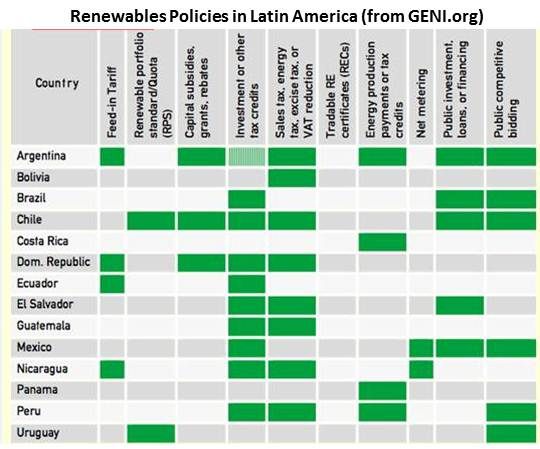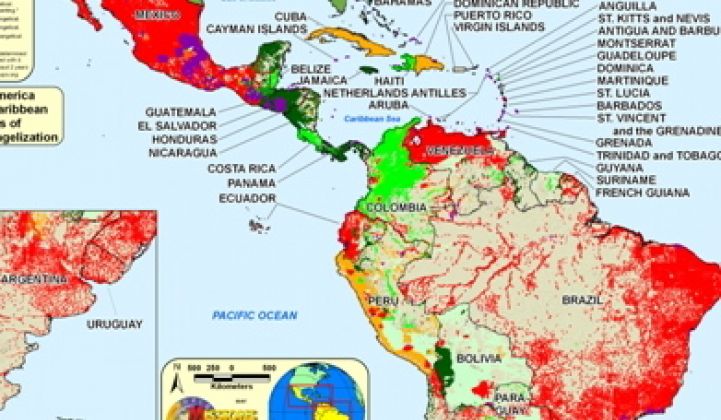Renewables advocates warn that if Congress doesn't provide incentives, the U.S. will lose an enormous greentech opportunity to China. Germany and Japan are also reaching for the renewables gold ring, and other EU and Asian nations are rapidly growing new energy economies.
And multinational developers, weary of fighting U.S. policy and regulatory resistance, are starting to take note of untapped renewables riches in Latin America's emerging economies.
In both wind and solar, Latin America has “an enormous resource potential,” according to Global Energy Network Institute (GENI) President Peter Miesen, as well as “policies in place” to drive development.
There is already incipient growth, Miesen said in an Agrion Global Network for Energy presentation. In addition, established manufacturers and developers, especially those in Spain who share both a language and a cultural history, may have a unique opportunity in Latin America. He was suggesting, but did not name, Spanish multinational renewables powerhouses like Iberdrola, Gamesa, and Acciona.
From the middle of the last decade, growth in Latin America’s installed wind capacity has been greater than that of any of the world’s leaders except China. There is now, Miesen said, a cumulative 2,500 megawatts of wind power, largely in Brazil and Mexico, with some development in Costa Rica and Argentina.
“Just a toe in the water” is how Miesen described Latin America’s approximately 200 megawatts of installed solar capacity. “The region is blessed with solar [resources] but nobody has taken up the charge.” There is also, he said, little solar manufacturing capability, and what is there is essentially limited to Mexico and Argentina.

Miesen talked briefly about specific countries, comparing the “very intense” wind in Argentina and Patagonia to Europe’s rich offshore potential. He also likened the “immense” insolation in Mexico’s Sonoran Desert to the Saharan solar abundance that spawned Europe’s multibillion-dollar Desertec development plan.
“Every one of these resource-rich Latin American countries could meet all of their needs with renewables,” Miesen said, though most “require major new transmission.” Brazil is a notable exception, Miesen pointed out, because there are abundant winds immediately adjacent to Sao Paulo, Brasilia and Rio de Janeiro.
But natural resources are not enough, as Washington’s intermittent policy support of renewables has proven. “You’ve got to get the rules right,” Miesen said, “to get developers to go in.” And Latin America, he said, “has some pretty progressive policies in place.”
Policy, Miesen said, should serve two purposes: to secure energy resources and to drive costs down.
In Latin America, securing wind and solar resources would (1) relieve the region of its nearly 70 percent dependence on a hydroelectric supply that is now threatened by climate change-driven droughts, and (2) interrupt the region’s growing dependence on price-volatile natural gas.
Costs for wind and solar, Miesen added, have been falling steadily. World wind turbine oversupply and technology advances have recently driven the cost of wind energy down. And solar in Latin America has fallen steadily from $10.87 per watt in 1998 to $7.16 per watt in 2010.
Policies now in place in Latin America, such as feed-in tariffs, renewables standards, fiscal incentives and financing and loan plans, Miesen said, are expected to reduce the cost of solar generated electricity from its present 12 to 15 cents per kilowatt-hour to 8 to 9 cents in 2020.
As important, Miesen said, is the fact that countries such as Chile, Costa Rica, and Uruguay have recently earned high scores from the World Bank for governance and rule of law. Also, Uruguay has set a 2015 goal of 1,000 megawatts of wind, while Chile has a 2024 target of ten percent renewables. “Many Latin American countries are setting up strong legal and policy frameworks,” he said, “but so far there is little investment and no steel in the ground.”

Also emerging in Latin America are regional partnerships that will facilitate growth. Miesen described two:
(1) The Sistema de Interconexion Electricas de los Paises de America Central (SIEPAC) will link Central America, from Guatemala and El Salvador to Panama, via a 230 kV transmission line that will keep renewables’ variability from being a development barrier.
(2) MERCOSUR is a Uruguayan-driven partnership linking it and its one-gigawatt wind power goal to Paraguay's hydroelectric resource, the second biggest in the world, and to Brazil’s barely tapped wind riches.
Miesen noted two significant challenges ahead. The world’s failure to extend or replace the Kyoto Accords' U.N. Clean Development Mechanism (CDM) may mean diminished funding of developing nations’ renewables projects. And, he stressed, Latin America needs to develop a centralized source of data and policy information.
At a recent wind conference, one of the industry’s pioneers talked about his experiences in emerging markets. The third project is the key, he said.
The first is easy because it is usually backed by the government. The second is easy because it is usually a smaller, private project for on-site use.
But after those, he said, developers begin to see opportunity. If a developer can build that third one -- which usually requires some local private sector financing, some transmission, a permitting regime and some local skill -- it demonstrates true market potential.
Brazil, with one of the world’s biggest emerging economies and one of the world’s finest wind resources, has completed that third project, he noted.



